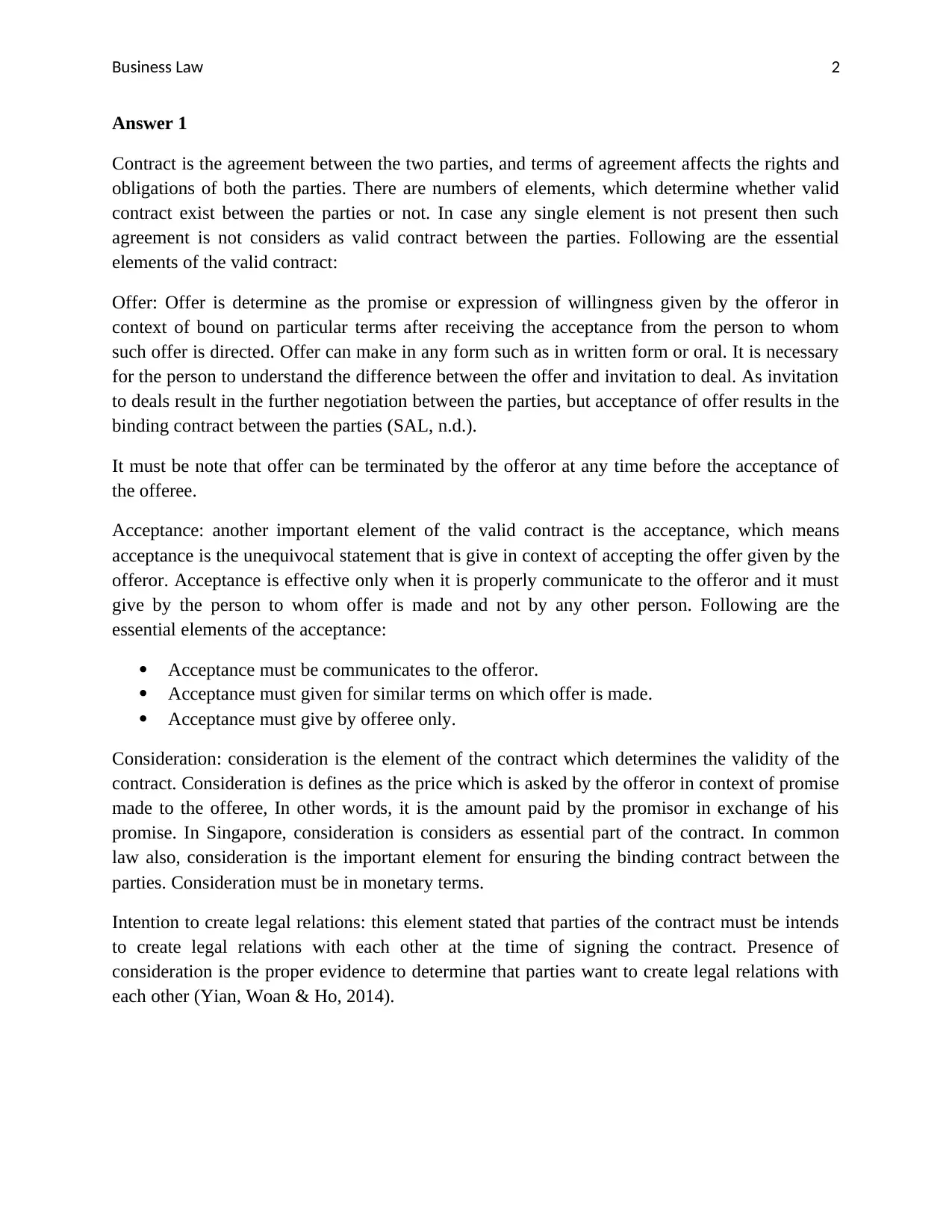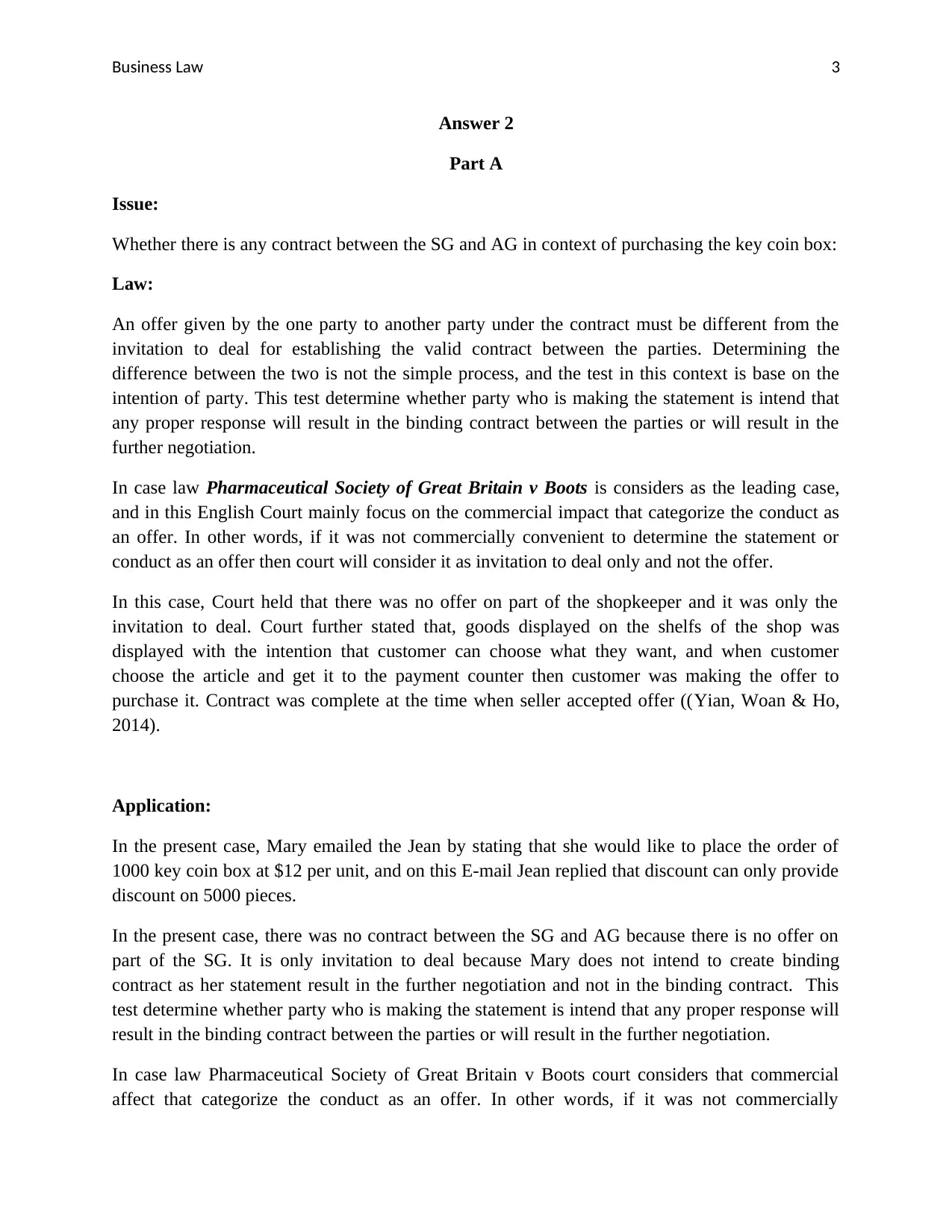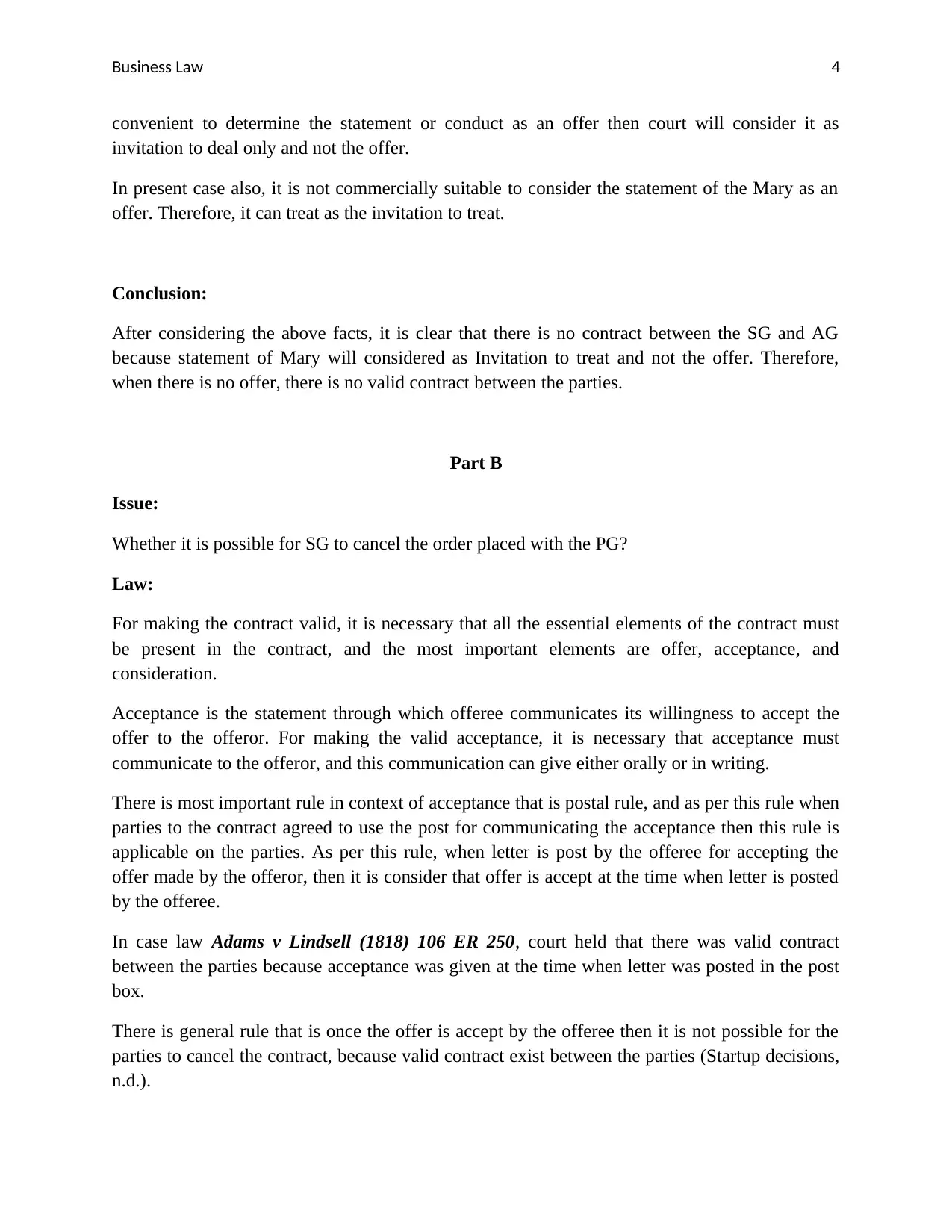Law 0115: Contract Law - Elements, Offer, Acceptance & Case Studies
VerifiedAdded on 2023/06/10
|6
|1536
|329
Homework Assignment
AI Summary
This assignment provides a comprehensive overview of contract law, focusing on the essential elements required to form a valid contract, including offer, acceptance, consideration, and the intention to create legal relations. It differentiates between an offer and an invitation to treat, using the Pharmaceutical Society of Great Britain v Boots case as an example. The assignment also examines the postal rule concerning acceptance, referencing Adams v Lindsell. Through case analysis involving Safe Bank Ltd, All Gifts Pte Ltd, and PG, the solution determines whether a contract exists based on the principles discussed and whether an order can be canceled once acceptance is communicated. The document is intended to help students understand the key concepts of contract law and their practical application.

Business Law 1
Business law
Business law
Paraphrase This Document
Need a fresh take? Get an instant paraphrase of this document with our AI Paraphraser

Business Law 2
Answer 1
Contract is the agreement between the two parties, and terms of agreement affects the rights and
obligations of both the parties. There are numbers of elements, which determine whether valid
contract exist between the parties or not. In case any single element is not present then such
agreement is not considers as valid contract between the parties. Following are the essential
elements of the valid contract:
Offer: Offer is determine as the promise or expression of willingness given by the offeror in
context of bound on particular terms after receiving the acceptance from the person to whom
such offer is directed. Offer can make in any form such as in written form or oral. It is necessary
for the person to understand the difference between the offer and invitation to deal. As invitation
to deals result in the further negotiation between the parties, but acceptance of offer results in the
binding contract between the parties (SAL, n.d.).
It must be note that offer can be terminated by the offeror at any time before the acceptance of
the offeree.
Acceptance: another important element of the valid contract is the acceptance, which means
acceptance is the unequivocal statement that is give in context of accepting the offer given by the
offeror. Acceptance is effective only when it is properly communicate to the offeror and it must
give by the person to whom offer is made and not by any other person. Following are the
essential elements of the acceptance:
Acceptance must be communicates to the offeror.
Acceptance must given for similar terms on which offer is made.
Acceptance must give by offeree only.
Consideration: consideration is the element of the contract which determines the validity of the
contract. Consideration is defines as the price which is asked by the offeror in context of promise
made to the offeree, In other words, it is the amount paid by the promisor in exchange of his
promise. In Singapore, consideration is considers as essential part of the contract. In common
law also, consideration is the important element for ensuring the binding contract between the
parties. Consideration must be in monetary terms.
Intention to create legal relations: this element stated that parties of the contract must be intends
to create legal relations with each other at the time of signing the contract. Presence of
consideration is the proper evidence to determine that parties want to create legal relations with
each other (Yian, Woan & Ho, 2014).
Answer 1
Contract is the agreement between the two parties, and terms of agreement affects the rights and
obligations of both the parties. There are numbers of elements, which determine whether valid
contract exist between the parties or not. In case any single element is not present then such
agreement is not considers as valid contract between the parties. Following are the essential
elements of the valid contract:
Offer: Offer is determine as the promise or expression of willingness given by the offeror in
context of bound on particular terms after receiving the acceptance from the person to whom
such offer is directed. Offer can make in any form such as in written form or oral. It is necessary
for the person to understand the difference between the offer and invitation to deal. As invitation
to deals result in the further negotiation between the parties, but acceptance of offer results in the
binding contract between the parties (SAL, n.d.).
It must be note that offer can be terminated by the offeror at any time before the acceptance of
the offeree.
Acceptance: another important element of the valid contract is the acceptance, which means
acceptance is the unequivocal statement that is give in context of accepting the offer given by the
offeror. Acceptance is effective only when it is properly communicate to the offeror and it must
give by the person to whom offer is made and not by any other person. Following are the
essential elements of the acceptance:
Acceptance must be communicates to the offeror.
Acceptance must given for similar terms on which offer is made.
Acceptance must give by offeree only.
Consideration: consideration is the element of the contract which determines the validity of the
contract. Consideration is defines as the price which is asked by the offeror in context of promise
made to the offeree, In other words, it is the amount paid by the promisor in exchange of his
promise. In Singapore, consideration is considers as essential part of the contract. In common
law also, consideration is the important element for ensuring the binding contract between the
parties. Consideration must be in monetary terms.
Intention to create legal relations: this element stated that parties of the contract must be intends
to create legal relations with each other at the time of signing the contract. Presence of
consideration is the proper evidence to determine that parties want to create legal relations with
each other (Yian, Woan & Ho, 2014).

Business Law 3
Answer 2
Part A
Issue:
Whether there is any contract between the SG and AG in context of purchasing the key coin box:
Law:
An offer given by the one party to another party under the contract must be different from the
invitation to deal for establishing the valid contract between the parties. Determining the
difference between the two is not the simple process, and the test in this context is base on the
intention of party. This test determine whether party who is making the statement is intend that
any proper response will result in the binding contract between the parties or will result in the
further negotiation.
In case law Pharmaceutical Society of Great Britain v Boots is considers as the leading case,
and in this English Court mainly focus on the commercial impact that categorize the conduct as
an offer. In other words, if it was not commercially convenient to determine the statement or
conduct as an offer then court will consider it as invitation to deal only and not the offer.
In this case, Court held that there was no offer on part of the shopkeeper and it was only the
invitation to deal. Court further stated that, goods displayed on the shelfs of the shop was
displayed with the intention that customer can choose what they want, and when customer
choose the article and get it to the payment counter then customer was making the offer to
purchase it. Contract was complete at the time when seller accepted offer ((Yian, Woan & Ho,
2014).
Application:
In the present case, Mary emailed the Jean by stating that she would like to place the order of
1000 key coin box at $12 per unit, and on this E-mail Jean replied that discount can only provide
discount on 5000 pieces.
In the present case, there was no contract between the SG and AG because there is no offer on
part of the SG. It is only invitation to deal because Mary does not intend to create binding
contract as her statement result in the further negotiation and not in the binding contract. This
test determine whether party who is making the statement is intend that any proper response will
result in the binding contract between the parties or will result in the further negotiation.
In case law Pharmaceutical Society of Great Britain v Boots court considers that commercial
affect that categorize the conduct as an offer. In other words, if it was not commercially
Answer 2
Part A
Issue:
Whether there is any contract between the SG and AG in context of purchasing the key coin box:
Law:
An offer given by the one party to another party under the contract must be different from the
invitation to deal for establishing the valid contract between the parties. Determining the
difference between the two is not the simple process, and the test in this context is base on the
intention of party. This test determine whether party who is making the statement is intend that
any proper response will result in the binding contract between the parties or will result in the
further negotiation.
In case law Pharmaceutical Society of Great Britain v Boots is considers as the leading case,
and in this English Court mainly focus on the commercial impact that categorize the conduct as
an offer. In other words, if it was not commercially convenient to determine the statement or
conduct as an offer then court will consider it as invitation to deal only and not the offer.
In this case, Court held that there was no offer on part of the shopkeeper and it was only the
invitation to deal. Court further stated that, goods displayed on the shelfs of the shop was
displayed with the intention that customer can choose what they want, and when customer
choose the article and get it to the payment counter then customer was making the offer to
purchase it. Contract was complete at the time when seller accepted offer ((Yian, Woan & Ho,
2014).
Application:
In the present case, Mary emailed the Jean by stating that she would like to place the order of
1000 key coin box at $12 per unit, and on this E-mail Jean replied that discount can only provide
discount on 5000 pieces.
In the present case, there was no contract between the SG and AG because there is no offer on
part of the SG. It is only invitation to deal because Mary does not intend to create binding
contract as her statement result in the further negotiation and not in the binding contract. This
test determine whether party who is making the statement is intend that any proper response will
result in the binding contract between the parties or will result in the further negotiation.
In case law Pharmaceutical Society of Great Britain v Boots court considers that commercial
affect that categorize the conduct as an offer. In other words, if it was not commercially
⊘ This is a preview!⊘
Do you want full access?
Subscribe today to unlock all pages.

Trusted by 1+ million students worldwide

Business Law 4
convenient to determine the statement or conduct as an offer then court will consider it as
invitation to deal only and not the offer.
In present case also, it is not commercially suitable to consider the statement of the Mary as an
offer. Therefore, it can treat as the invitation to treat.
Conclusion:
After considering the above facts, it is clear that there is no contract between the SG and AG
because statement of Mary will considered as Invitation to treat and not the offer. Therefore,
when there is no offer, there is no valid contract between the parties.
Part B
Issue:
Whether it is possible for SG to cancel the order placed with the PG?
Law:
For making the contract valid, it is necessary that all the essential elements of the contract must
be present in the contract, and the most important elements are offer, acceptance, and
consideration.
Acceptance is the statement through which offeree communicates its willingness to accept the
offer to the offeror. For making the valid acceptance, it is necessary that acceptance must
communicate to the offeror, and this communication can give either orally or in writing.
There is most important rule in context of acceptance that is postal rule, and as per this rule when
parties to the contract agreed to use the post for communicating the acceptance then this rule is
applicable on the parties. As per this rule, when letter is post by the offeree for accepting the
offer made by the offeror, then it is consider that offer is accept at the time when letter is posted
by the offeree.
In case law Adams v Lindsell (1818) 106 ER 250, court held that there was valid contract
between the parties because acceptance was given at the time when letter was posted in the post
box.
There is general rule that is once the offer is accept by the offeree then it is not possible for the
parties to cancel the contract, because valid contract exist between the parties (Startup decisions,
n.d.).
convenient to determine the statement or conduct as an offer then court will consider it as
invitation to deal only and not the offer.
In present case also, it is not commercially suitable to consider the statement of the Mary as an
offer. Therefore, it can treat as the invitation to treat.
Conclusion:
After considering the above facts, it is clear that there is no contract between the SG and AG
because statement of Mary will considered as Invitation to treat and not the offer. Therefore,
when there is no offer, there is no valid contract between the parties.
Part B
Issue:
Whether it is possible for SG to cancel the order placed with the PG?
Law:
For making the contract valid, it is necessary that all the essential elements of the contract must
be present in the contract, and the most important elements are offer, acceptance, and
consideration.
Acceptance is the statement through which offeree communicates its willingness to accept the
offer to the offeror. For making the valid acceptance, it is necessary that acceptance must
communicate to the offeror, and this communication can give either orally or in writing.
There is most important rule in context of acceptance that is postal rule, and as per this rule when
parties to the contract agreed to use the post for communicating the acceptance then this rule is
applicable on the parties. As per this rule, when letter is post by the offeree for accepting the
offer made by the offeror, then it is consider that offer is accept at the time when letter is posted
by the offeree.
In case law Adams v Lindsell (1818) 106 ER 250, court held that there was valid contract
between the parties because acceptance was given at the time when letter was posted in the post
box.
There is general rule that is once the offer is accept by the offeree then it is not possible for the
parties to cancel the contract, because valid contract exist between the parties (Startup decisions,
n.d.).
Paraphrase This Document
Need a fresh take? Get an instant paraphrase of this document with our AI Paraphraser

Business Law 5
Application:
In the present case, Mary already gives its acceptance on the 8th march 2018 by posting the
cheque to the PG. In this postal rule is applicable and as per this rule when letter is posted by the
offeree for accepting the offer, then such offer is accepted at the time when letter is posted by the
offeree. Mary provides its acceptance in context of the offer made by the PG on sixth march
2008, and it is not possible to revoke the acceptance once it is given.
Conclusion:
AG cannot cancel the contract with the PG.
Application:
In the present case, Mary already gives its acceptance on the 8th march 2018 by posting the
cheque to the PG. In this postal rule is applicable and as per this rule when letter is posted by the
offeree for accepting the offer, then such offer is accepted at the time when letter is posted by the
offeree. Mary provides its acceptance in context of the offer made by the PG on sixth march
2008, and it is not possible to revoke the acceptance once it is given.
Conclusion:
AG cannot cancel the contract with the PG.

Business Law 6
References:
Adams v Lindsell (1818) 106 ER 250.
Pharmaceutical Society of Great Britain v Boots Court of Appeal [1953] 1 QB 401; [1953]
EWCA Civ 6; [1953] 1 All ER 482, [1953] 2 WLR 427
SAL. The law of contract. Available at:
http://www.singaporelaw.sg/sglaw/laws-of-singapore/commercial-law/chapter-8. Accessed on
19th July 2018.
Startup decisions. Contract Law in Singapore. Available at:
https://www.startupdecisions.com.sg/singapore/business-laws/contract-law/. Accessed on 19th
July 2018.
Yian, G., Woan, L. & Ho, T. (2014). Contract law. Available at:
https://ink.library.smu.edu.sg/cgi/viewcontent.cgi?article=3631&context=sol_research. Accessed
on 19th July 2018.
References:
Adams v Lindsell (1818) 106 ER 250.
Pharmaceutical Society of Great Britain v Boots Court of Appeal [1953] 1 QB 401; [1953]
EWCA Civ 6; [1953] 1 All ER 482, [1953] 2 WLR 427
SAL. The law of contract. Available at:
http://www.singaporelaw.sg/sglaw/laws-of-singapore/commercial-law/chapter-8. Accessed on
19th July 2018.
Startup decisions. Contract Law in Singapore. Available at:
https://www.startupdecisions.com.sg/singapore/business-laws/contract-law/. Accessed on 19th
July 2018.
Yian, G., Woan, L. & Ho, T. (2014). Contract law. Available at:
https://ink.library.smu.edu.sg/cgi/viewcontent.cgi?article=3631&context=sol_research. Accessed
on 19th July 2018.
⊘ This is a preview!⊘
Do you want full access?
Subscribe today to unlock all pages.

Trusted by 1+ million students worldwide
1 out of 6
Related Documents
Your All-in-One AI-Powered Toolkit for Academic Success.
+13062052269
info@desklib.com
Available 24*7 on WhatsApp / Email
![[object Object]](/_next/static/media/star-bottom.7253800d.svg)
Unlock your academic potential
Copyright © 2020–2025 A2Z Services. All Rights Reserved. Developed and managed by ZUCOL.




